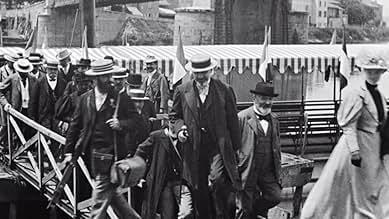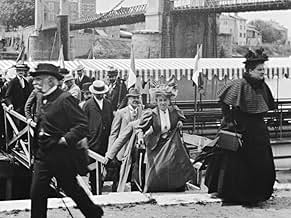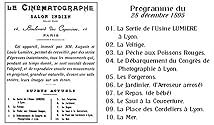NOTE IMDb
5,7/10
2,1 k
MA NOTE
Ajouter une intrigue dans votre langueThe photographers who need to participate in the congress of Lyon get off a boat in Neuville-sur-Saône, dividing to the right and left.The photographers who need to participate in the congress of Lyon get off a boat in Neuville-sur-Saône, dividing to the right and left.The photographers who need to participate in the congress of Lyon get off a boat in Neuville-sur-Saône, dividing to the right and left.
- Réalisation
- Casting principal
P.J.C. Janssen
- Self
- (non crédité)
Avis à la une
Louis Lumiere was a businessman. Since he was in the photographic business (his families factory in Lyon, France produced what many considered to be the best treated glass plates used in photography at that time - the mid 1890s), he was also a photographer. But, I am sure, he considered himself first-and-foremost a scientist. He considered his new invention, the Cinematopgraph, to be a scientific instrument. That is why during 1894 and 1895, he spent quite a bit of effort to gain approbation from various scientific groups. He wanted to keep the photographic community, in which he was well known, appraised of his endeavors. One method of doing this was to attend, in June 1895, a congress of photographers that was gathering at Neuville-Sur-Soane - a town just a short distance north of Lyon.
Louis positioned his camera at the base of a gangplank down which delegates to the conference descended from a Soane river ferry. Certainly, all of the descending men and women knew, by that time, of Louis' invention - although it had not yet been made public. Later that evening the Lumiere brothers showed the congress attendees eight of their less-than-one-minute films. And in one of these films the members saw themselves descending from the boat.
Louis positioned his camera at the base of a gangplank down which delegates to the conference descended from a Soane river ferry. Certainly, all of the descending men and women knew, by that time, of Louis' invention - although it had not yet been made public. Later that evening the Lumiere brothers showed the congress attendees eight of their less-than-one-minute films. And in one of these films the members saw themselves descending from the boat.
Considering that the Photographical Congress arriving in Lyon was a major event, I suppose you could call this one more important than the Lumiere Brothers' previous efforts because the event is something that most people wouldn't see a lot of the time. This film captures simply what the title suggests: a whole crowd of photographers coming off a ferry. Indeed quite a few of the photographers notice the camera and while some tip their hats in greeting, others notice the camera and refuse to be part of the film by dashing off the screen quickly.
At only a minute watching, this short documentary isn't a waste of time. It will probably only be interesting to people like me who, believe it or not, somehow find entertainment in watching these things. Audiences nowadays will find it pretty uninteresting--except for if you're a historian. In that case it's a must-see.
At only a minute watching, this short documentary isn't a waste of time. It will probably only be interesting to people like me who, believe it or not, somehow find entertainment in watching these things. Audiences nowadays will find it pretty uninteresting--except for if you're a historian. In that case it's a must-see.
To many historians, December 28, 1895, is the date considered as the day where cinema was born, as it was in that cold day of winter when the brothers Auguste and Louis Lumière gave the first public screening of their new invention, the Cinématographe. The brothers' devise would change history of entertainment forever, as it took the idea of motion pictures from the uncomfortable and individual experience of Edison's Kinetoscope, to the more enjoyable atmosphere of a movie projected on a screen. On that day the brothers showed 10 films, and the majority of them were of the kind that later would be known as "actuality films", movies showing an everyday event. However, one of the 10 films was a bit more than a typical "actuality film", as it was actually the register of an event in a fashion more akin to what we know now as documentary films: it was the arrival of the Photographical Congress to Lyon.
While December 28, 1895, was certainly the very first time the brothers showed their invention to the world, it wasn't really the first time the brothers' invention was shown to an audience, as months earlier, the brothers had been doing private screenings for the scientific community of France. The 1895 Photographical Congress that was celebrated at the community of Neuville-sur-Saône in Lyon, was one of the places where the Lumières screened their films for the first time. "Neuville-sur-Saône: Débarquement du congrès des photographes à Lyon", is essentially the recording of the arrival of the members of the Photographical Congress to Neuville-sur-Saône, marking the first time a camera was used to capture something more "special" than people moving or trains arriving. This time the new medium was being used to actually register the event in real time, pretty much in the same way as TV News work today.
Nevertheless, that was not the only thing that "Neuville-sur-Saône" an interesting early short film. The movie was shot when the Congress arrived, early in the morning, and that very same day was shown to its protagonists in the afternoon. One has to wonder how the photographers felt when they saw the images of their arrival actually moving, as if the even was being enacted again. The very same people that looked into the camera (perhaps thinking it was a normal photography) was now watching themselves in a motion picture depicting short seconds of their lives. It was certainly a unique experience, and no doubt the success of "Neuville-sur-Saône: Débarquement du congrès des photographes à Lyon" and their other films that day prompted the brothers to keep working in their preparation for that December day, when the world witnessed what a group of photographers did (and saw) months ago. 7/10
While December 28, 1895, was certainly the very first time the brothers showed their invention to the world, it wasn't really the first time the brothers' invention was shown to an audience, as months earlier, the brothers had been doing private screenings for the scientific community of France. The 1895 Photographical Congress that was celebrated at the community of Neuville-sur-Saône in Lyon, was one of the places where the Lumières screened their films for the first time. "Neuville-sur-Saône: Débarquement du congrès des photographes à Lyon", is essentially the recording of the arrival of the members of the Photographical Congress to Neuville-sur-Saône, marking the first time a camera was used to capture something more "special" than people moving or trains arriving. This time the new medium was being used to actually register the event in real time, pretty much in the same way as TV News work today.
Nevertheless, that was not the only thing that "Neuville-sur-Saône" an interesting early short film. The movie was shot when the Congress arrived, early in the morning, and that very same day was shown to its protagonists in the afternoon. One has to wonder how the photographers felt when they saw the images of their arrival actually moving, as if the even was being enacted again. The very same people that looked into the camera (perhaps thinking it was a normal photography) was now watching themselves in a motion picture depicting short seconds of their lives. It was certainly a unique experience, and no doubt the success of "Neuville-sur-Saône: Débarquement du congrès des photographes à Lyon" and their other films that day prompted the brothers to keep working in their preparation for that December day, when the world witnessed what a group of photographers did (and saw) months ago. 7/10
From a boat descend the photographers who must participate in the congress of Lyone dividing in two diagonals to the right and left. After, someone greets the film operator. So the illusion of the dimension of the cinema is broken.
This film is a virtual remake of 'Sortie d'Usine', perhaps making it the first self-referential movie. Instead of the workers streaming out of the factory, we have fellow cinematograph specialists disembarking a liner for a congress. Instead of workers silently doing their masters' bidding, we have colleagues, friends, peers, fearlessly greeting the camera as equals.
This is a film about film - the Congressionists walk with their cameras; this film was precessed immediately for viewing at the conference. Already, the Lumieres' desire to 'objectively' record the world has turned into a naval-gazing admission of defeat, of the impossibility of objectivity untainted by subjectivity or ideology. Godard once suggested that the most honest film would be of a camera recording itself in a mirror. This film is an early grasping of what he means.
This is a film about film - the Congressionists walk with their cameras; this film was precessed immediately for viewing at the conference. Already, the Lumieres' desire to 'objectively' record the world has turned into a naval-gazing admission of defeat, of the impossibility of objectivity untainted by subjectivity or ideology. Godard once suggested that the most honest film would be of a camera recording itself in a mirror. This film is an early grasping of what he means.
Le saviez-vous
- ConnexionsEdited into The Lumière Brothers' First Films (1996)
Meilleurs choix
Connectez-vous pour évaluer et suivre la liste de favoris afin de recevoir des recommandations personnalisées
Détails
- Date de sortie
- Pays d’origine
- Langue
- Aussi connu sous le nom de
- Arrivée des congressistes à Neuville-sur-Saône
- Lieux de tournage
- Société de production
- Voir plus de crédits d'entreprise sur IMDbPro
- Durée
- 1min
- Couleur
- Mixage
- Rapport de forme
- 1.33 : 1
Contribuer à cette page
Suggérer une modification ou ajouter du contenu manquant





















